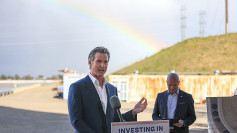Renewable energy progress in the U.S. fell far short of what is required to meet climate goals in 2021, a new report reveals.
A large proportion of renewable energy capacity that was planned to come online last year has been pushed back by a year or two. According to a new report by trade association American Clean Power (ACP), the development pipeline was approximately 50% larger at the end of 2021 than it was at the end of 2020.
"Although the US has reached this incredible achievement, more needs to be done, at a faster pace, to reach the climate goals and targets our country needs to achieve," ACP CEO Heather Zichal said in a statement.
In 2021, the U.S. deployed over 28 gigawatts (GW) of wind, solar, and energy storage capacity, according to ACP, which is less than half of what is required to meet Joe Biden's objective of a carbon-free power grid by 2035.
Also last year, the U.S. wind and solar industries trekked through supply chain interruptions, increased commodity prices and shipping costs, and legislative uncertainty, resulting in a 3% dip from 2020's record rate of sustainable energy installations.
Globally, 2021 still set a new milestone for renewable energy growth. However, there were specific barriers to wind and solar deployment in the United States. In June, the Department of Homeland Security imposed restrictions on silica-based products linked to human rights violations in China's Xinjiang Uyghur Autonomous Region.
Customs inspectors have begun seizing solar panels and other silica-based items from a Chinese company accused of forced labor. This might "further delay projects or even lead to their cancellation," according to ACP's assessment. Xinjiang generates over 45% of the world's solar-grade polysilicon, with the blacklisted company being the main manufacturer in the region.
Wind energy, on the other hand, faced a distinct issue. Last year, after a significant increase in new wind farms in 2020, there was a 25% reduction in installations. During the COVID-19 lockdowns, the sector urged the Biden administration to prolong a crucial wind tax incentive that was slated to expire in 2020. Although they were eventually granted a one-year extension, the initial uncertainty was enough to slow growth.
The year 2021 did have a silver lining: batteries had a stellar year. In the U.S., utility battery storage installations increased by a stunning 196%. The foundation of a sustainable system is energy storage; batteries make solar and wind energy available when gusts settle and sunlight fades. And we still need a lot more of them.
Today, the capacity of large-scale battery power in the U.S. is about similar to that of a few large power plants.






